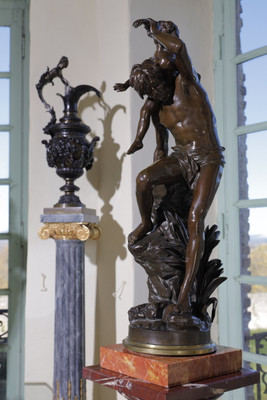A bronze sculpture with a brown patina depicting King David victorious over Goliath. It rests on a circular base decorated with oriental motifs. Signed in relief on the base: "A. Mercié". Foundry: Barbedienne. Mechanical reduction: COLAS. The plaster model of "David" was executed by Antonin Mercié at the Villa Medici in Rome between 1869 and 1870. Reflecting the political realities of the time, particularly the defeat of 1870, the sculpture quickly became enormously popular: the plaster cast, which earned the young artist the Legion of Honor, was commissioned in bronze by the State in 1872, exhibited at the Salon of the same year, and then placed in the Musée du Luxembourg in 1874. It became one of the most widely circulated images in illustrated newspapers and enjoyed such enthusiasm that it was produced in a smaller size and in six different dimensions by the Barbedienne foundry. A marble version was presented at the 1889 Universal Exhibition and a plaster version at the 1900 Universal Exhibition. Other life-size bronze versions are in the Musée d'Orsay in Paris and the Musée des Beaux-Arts in Toulouse. Bibliography: Catalogue of works in the Musée d'Orsay (http://www.musee-orsay.fr/fr/collections/catalogue-des-oeuvres/notice.html?no_cache=1&nnumid=16003) 19th century, Circa: 1880 Dimensions: W: 34cm, D: 33cm, H: 74cm.
- Reference :
- 1953
- Availability :
- Sold
- Width :
- 34 (cm)
- Height :
- 74 (cm)
- Depth :
- 33 (cm)
- Identify Exists:
- False




















